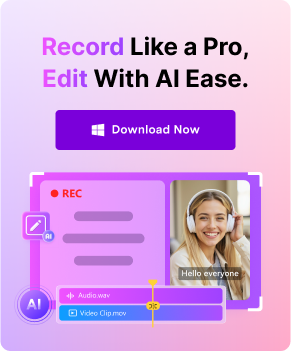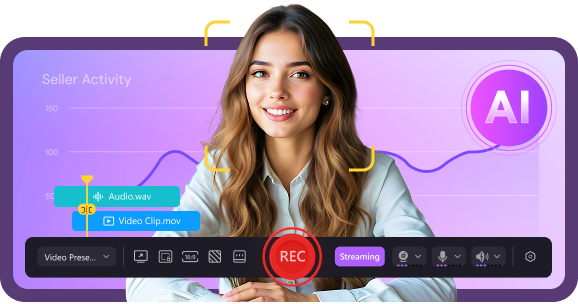Podcasting has grown into one of the most popular mediums for sharing ideas, stories, and expertise. However, creating an engaging podcast requires more than just recording your thoughts—it demands careful editing to ensure high-quality audio and a seamless listening experience. Whether you're a seasoned podcaster or a beginner, this guide explores the essentials of podcast editing, from understanding its importance to using tools like AI podcast editing software. We’ll also delve into techniques to enhance audio quality and tools such as Descript podcast editor and Wondershare DemoCreator for achieving professional results.
In this article
Part 1: Understanding Podcast Editing

Podcast editing is the process of transforming raw audio recordings into a polished and professional final product. This involves a range of tasks, such as trimming unnecessary sections, removing mistakes, balancing audio levels, and eliminating background noise. Additionally, podcast editors often enhance content by adding intro/outro music, sound effects, and smooth transitions to create a dynamic listening experience. The goal is to produce clear, engaging audio that captivates listeners while maintaining a high standard of quality.
Editing is crucial for ensuring your podcast sounds professional and resonates with your audience. High-quality editing enhances clarity by removing distractions like static or overlapping speech, making it easier for listeners to stay focused. It also helps maintain engagement by optimizing pacing, ensuring that each episode flows seamlessly. For businesses and content creators, well-edited podcasts reflect credibility and professionalism, which can reinforce brand authority and foster trust with the audience. In a competitive podcasting space, effective editing is essential for creating content that stands out and keeps listeners coming back for more.
Part 2: Why Podcast Editing Matters
Podcast editing is a critical step in creating content that captivates and retains your audience. It ensures that your episodes are polished, professional, and engaging, making them stand out in a crowded market. By focusing on quality and consistency, editing helps build trust, enhance listener satisfaction, and improve your podcast's discoverability.
- Improved Audio Quality: Editing removes background noise, adjusts volume inconsistencies, and enhances clarity, ensuring your podcast is easy to listen to.
- Enhanced Listener Engagement: Polished content with smooth transitions and well-paced dialogue keeps your audience engaged throughout the episode.
- Professional Appeal: Professionally edited podcasts stand out in a competitive market, helping you build credibility and attract more listeners.
- SEO and Discoverability: Adding clear titles, descriptions, and show notes during the editing process improves your podcast's visibility on platforms like Spotify and Apple Podcasts.
- Content Consistency: Regular editing maintains a consistent tone and quality, building trust with your audience over time.
Part 3: Tools for Editing Podcasts
Having the right tools is essential for producing high-quality podcasts. From basic editing to advanced noise reduction and multi-track capabilities, these tools cater to different levels of expertise and needs. Here’s a look at some of the best podcast editing tools available to help you create professional and engaging episodes.
1. Wondershare DemoCreator
Wondershare DemoCreator is a beginner-friendly yet powerful tool for podcast editing, offering a range of features to enhance audio and video podcasts. Its intuitive interface and AI-powered capabilities make it ideal for both amateurs and professionals looking to create polished content. DemoCreator excels in denoising audio, adjusting sound levels, and adding background music or transitions seamlessly. The tool’s compatibility with both Windows and macOS ensures accessibility for diverse users. Whether you’re starting a new podcast or improving existing episodes, DemoCreator simplifies the editing process with its versatile toolkit.

Key Features:
- AI-powered noise reduction to remove background distractions.
- Real-time audio waveform visualization for precise editing.
- Multi-track editing for adding music, sound effects, and voiceovers.
- Compatibility with both audio and video podcasts.
- Easy export options in multiple formats.
2. Adobe Audition
Adobe Audition is a professional-grade audio editing software trusted by podcasters, sound engineers, and media creators worldwide. Known for its advanced capabilities, it provides precise control over multitrack editing, noise reduction, and audio restoration. With tools like spectral frequency display and batch processing, Audition is designed for complex audio projects requiring meticulous attention to detail. Its integration with Adobe Creative Cloud ensures smooth workflows for users already working with Adobe tools. Ideal for seasoned professionals, Adobe Audition delivers high-quality audio results that stand out in competitive podcasting.

Key Features:
- Spectral frequency display for precise noise removal.
- Advanced noise reduction effects.
- Multitrack editing for complex podcast production.
- DeReverb effect to remove echo and reverb.
- Integration with Adobe Creative Cloud for seamless workflows.
3. Audacity
Audacity is a popular open-source audio editing software that offers robust features at no cost. Its straightforward interface and essential editing tools make it a go-to choice for beginner podcasters and those on a budget. Despite being free, Audacity includes useful features such as noise reduction, multi-track editing, and volume normalization. The software is compatible with Windows, macOS, and Linux, making it widely accessible. For podcasters seeking a cost-effective solution, Audacity combines simplicity with functionality, providing all the basics needed to produce quality audio content.

Key Features:
- Noise reduction tool to clean up recordings.
- Volume normalization and equalization.
- Multi-track editing for layering audio.
- Cross-platform compatibility.
- Plugin support for extended functionality.
4. Alitu
Alitu is a web-based podcast editing tool designed to simplify the entire production process for podcasters. Its AI-driven capabilities allow users to clean audio, add music, and assemble episodes with minimal effort. With built-in templates for intros, outros, and transitions, Alitu helps users produce professional-sounding podcasts quickly. The platform’s hosting integration further streamlines the workflow, allowing users to upload finished episodes directly to podcast directories. Ideal for podcasters with limited technical skills or time, Alitu combines automation with ease of use for a stress-free editing experience.

Key Features:
- Automatic noise reduction and audio cleanup.
- Built-in hosting integration.
- Episode builder for easy assembly.
- Music and intro/outro templates.
- Cloud-based functionality.
5. Hindenburg Journalist
Hindenburg Journalist is a specialized podcast editing software tailored for storytelling and dialogue-based content. It offers unique features like automatic voice leveling and voice profiling to ensure consistent audio quality. The software’s non-destructive editing approach allows users to make changes without affecting the original recording. Hindenburg Journalist also includes built-in publishing tools, making it easier to upload episodes directly to podcast directories. With a focus on simplicity and high-quality output, this tool is perfect for podcasters and radio professionals who prioritize storytelling clarity.

Key Features:
- Automatic voice leveling for consistent audio quality.
- Voice profiler for optimizing specific voices.
- Multitrack editing for layering audio.
- Built-in publishing tools for direct uploads.
- Non-destructive editing for flexibility.
6. Descript
Descript revolutionizes podcast editing with its innovative text-based approach, allowing users to edit audio as easily as editing a document. Its standout feature, Overdub, enables users to create AI-generated voiceovers, while automatic transcription saves hours of manual work. Descript combines these unique tools with traditional features like noise reduction, multitrack editing, and audio enhancement. The platform’s versatility makes it suitable for audio and video podcasters alike. For creators seeking cutting-edge technology to streamline their workflow, Descript offers a modern solution with unmatched convenience.

Key Features:
- Text-based audio editing.
- Overdub feature for generating AI voices.
- Automatic transcription for fast editing.
- Multi-track editing for layering content.
- Noise reduction and audio cleanup tools.
Part 4: Step-by-Step Guide On Recording And Editing Podcasts
1. Wondershare DemoCreator
How to Edit Podcasts using DemoCreator:
Whether you’re a beginner or a seasoned podcaster, DemoCreator’s features make it easy to create polished, high-quality episodes that captivate your audience. Let’s explore how DemoCreator can transform your podcast editing workflow step by step!
Step 1Set Up the Project and Record Audio/Video
Launch Wondershare DemoCreator and create a new project. Select the recording mode based on your needs—screen recording, microphone audio, or webcam. Adjust the audio input settings for clarity and ensure the microphone is properly configured. Once ready, click the record button to capture your podcast audio or video.

Step 2Import Audio Files for Editing
After recording, import additional audio files (if necessary) by clicking the “Import” button in the media library. Drag and drop the files onto the timeline for editing. Arrange your segments in the desired order and trim any unwanted parts to refine your podcast’s structure.

Step 3Utilize the Denoise Feature to Enhance Audio Quality
Select the audio track in the timeline and access the Audio Properties panel. Enable the Denoise option to remove background noise and improve clarity. Adjust the denoise settings for optimal results, ensuring a clean and professional sound for your podcast. Preview the changes to confirm the quality.

Step 4Add Music, Sound Effects, and Transitions
Enhance your podcast by dragging music or sound effects onto the timeline. Use transitions to smooth out cuts or changes between segments. Adjust the audio levels to ensure a balanced mix, and preview the final composition. Once satisfied, export the edited podcast in your preferred format and share it with your audience.

2. Adobe Audition
How to Edit Podcasts using Adobe Audition:
Explore how Adobe Audition can streamline your podcast editing process and take your content to the next level!
Step 1Import Audio Files into the Workspace
Launch Adobe Audition and open the Multitrack Session option to start a new project. Drag and drop your audio files into the workspace or use the File > Import menu to load them. Once imported, organize your files on separate tracks, ensuring each component (voice, music, sound effects) is placed for easy access and editing.

Step 2Use Multi-Track View for Complex Edits
In the Multitrack View, you can layer, synchronize, and edit multiple audio tracks. Adjust the volume levels, apply effects like equalization or compression, and add transitions between segments. Use the zoom and snap tools to align sections precisely and create a seamless flow in your podcast.

Step 3Apply Noise Reduction Techniques to Clean Up Audio
To enhance audio quality, switch to the Waveform Editor and highlight a section of the audio containing only background noise. Navigate to Effects > Noise Reduction/Restoration > Capture Noise Print to let Audition identify the noise profile. Apply the Noise Reduction (Process) effect to the entire track and fine-tune the reduction and sensitivity sliders for optimal results. Preview the changes to ensure clarity without distorting the natural sound.

Step 4Export the Final Mix in Desired Formats
Once satisfied with the edits, go to File > Export > Multitrack Mixdown > Entire Session to save your podcast. Choose the desired format (e.g., WAV, MP3) and set the quality settings before exporting. The final mix is now ready for sharing or uploading to podcast platforms.

Part 5: Tips for Effective Podcast Editing
Effective podcast editing is essential to deliver a high-quality listening experience that keeps your audience engaged. By focusing on clarity, pacing, and consistency, you can create episodes that resonate with your listeners and stand out in a competitive market. Below are key tips to help you refine your podcast editing process.
1. Focus on Clarity: Clear dialogue is critical to a professional podcast. Start by removing background noise using tools like noise reduction features in AI podcast editing software. Equalize audio levels across all tracks to ensure consistent volume, and compress dynamic ranges to prevent parts of the recording from sounding too loud or too soft. Clarity ensures your audience doesn’t struggle to understand your content.
2. Keep it Engaging: Music, sound effects, and transitions can elevate your podcast’s appeal, but overusing them can overwhelm the content. Use these enhancements sparingly to add emphasis or set the tone without distracting from the main dialogue. For example, a short intro music clip or subtle sound effects can create a professional vibe without detracting from your message.
3. Trim Excess: Long pauses, filler words like “um” or “uh,” and off-topic tangents can disrupt the flow of your podcast. Edit these out to maintain a focused and concise episode. Aim to keep your content tight and relevant to your audience’s expectations, ensuring their time is well-spent and their attention is retained.
4. Test the Output: After editing, listen to the final version of your podcast on various devices, such as headphones, speakers, and mobile devices. This ensures consistent audio quality across different playback environments. Testing helps identify issues like uneven volume levels or background noise that may not be noticeable during editing.
5. Save Backups: Always save multiple versions of your project at different stages of editing. Backups protect your progress in case of technical failures or errors, allowing you to revert to an earlier version if needed. Use cloud storage or external drives to ensure your files are secure and easily accessible.
Conclusion
Podcast editing is an essential part of creating engaging, professional-quality content that resonates with your audience. By using tools like Wondershare DemoCreator, Descript podcast editor, and Adobe Audition, you can enhance audio clarity, remove distractions, and craft polished episodes. Whether you're relying on AI podcast editing or traditional methods, the right tools and techniques ensure your podcast stands out in the ever-growing podcasting world.
FAQ
-
Q1: What is the best software for podcast editing?
Adobe Audition, Descript, and Wondershare DemoCreator are excellent options, each offering unique features for different needs. -
Q2: How can I improve my podcast's audio quality?
Use noise reduction, equalization, and compression tools to enhance clarity and balance audio levels. -
Q3: What features should I look for in podcast editing software?
Look for noise reduction, multi-track editing, audio effects, and export options for flexibility and quality. -
Q4: Can I use Wondershare DemoCreator for video podcasts?
Yes, Wondershare DemoCreator supports video podcasting with tools for recording, editing, and exporting in multiple formats. -
Q5: How do I remove background noise from my podcast recordings?
Use tools like DemoCreator or Adobe Audition to apply noise reduction effects and adjust audio settings for cleaner sound.



